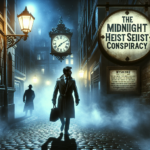Chapter 1: The Call of the Unknown
In the far reaches of the Andromeda Galaxy, where stars danced in a resplendent waltz and nebulae unfurled in vibrant colors, lay the planet Elysium. It was a world of breathtaking beauty, a jewel of diversity and innovation. Yet, for all its allure, it was the mysteries of the cosmos that called its inhabitants to look beyond their azure skies.
Among those dreamers was Lira Elandra, a young astronomer whose heart thrummed with the rhythm of the universe. Her parents had named her after a constellation, hoping she would reach for the stars. And indeed, she had, spending countless nights gazing through the telescope atop the Astral Summit Observatory, a beacon of curiosity and enlightenment.
Lira’s life had been one of routine and discovery, but that balance shifted one fateful evening when a message from the stars broke the silence of space. It was not composed of words, but a sequence of harmonious tones and radiant pulses that defied all known forms of communication. To Lira, it was as if the universe itself had composed a symphony, a “Symphony of Luminous Horizons.”
At first, Lira believed it to be a cosmic anomaly, a star’s dying breath echoing across the void. Yet, the patterns were too deliberate, too structured to be dismissed as celestial noise. The realization struck her with the force of a supernova; the symphony was a message from an intelligent source.
Chapter 2: Harmonies and Dissonance
Driven by an insatiable curiosity, Lira dedicated herself to deciphering the symphony’s intricate patterns. She fed the data into computational models, seeking correlations with known cosmic phenomena. As the days turned into weeks, she felt herself becoming part of the melody, the music weaving through her thoughts with a seductive complexity.
Her colleagues at the observatory, though skeptical at first, found themselves drawn to her passion. Professor Kaelen, a renowned astrophysicist with a penchant for the unconventional, became her staunchest ally. Together, they pored over the data, their debates echoing through the observatory’s halls like the symphony itself.
Lira and Kaelen’s efforts bore fruit when they discovered that the symphony’s structure resembled a form of mathematical language, a universal code that transcended the barriers of spoken word. Each note, each luminous pulse, corresponded to a mathematical constant or principle, revealing the intelligence of its creators and the grandeur of their intentions.
The revelation was staggering. Here was proof of a civilization that not only understood the cosmos but could communicate its essence through music. Yet, the message was incomplete, akin to a riddle missing its final stanza. As Lira and Kaelen delved deeper, they faced a new challenge: how to respond to a language they could barely comprehend.
Chapter 3: The Celestial Conductor
As the symphony continued to weave its spell, a sense of urgency took root in Lira’s heart. The message was not merely an intellectual curiosity but a call to action. She began to perceive it as an invitation, a beckoning hand from across the stars.
In a bid to decode the symphony further, Lira enlisted the help of Eldrin, a brilliant mind and an expert in quantum harmonics. Eldrin’s work in the field of quantum acoustics had earned him respect and ridicule in equal measure, but Lira believed he held the key to unlocking the symphony’s secrets.
With Eldrin’s unique perspective, they began to map the symphony’s structure onto cosmic events—supernovae, black holes, and pulsars—finding correlations that hinted at a cosmic scale of understanding. It was as if the composers had traversed the universe, gathering the melodies of creation itself to craft their message.
Under Eldrin’s guidance, Lira discovered a hidden element within the symphony, a tributary of notes and light that diverged from the main melody. It was a signature, a distinct motif that suggested intent and anticipation. The celestial conduits were open, and the time to respond was fast approaching.
Chapter 4: A Response in Harmony
With the pieces of the puzzle falling into place, Lira, Kaelen, and Eldrin embarked on crafting a response. It was a daunting task; they had to compose a symphony that would resonate across the cosmos, a counterpoint to the message they had received.
They worked tirelessly, blending science with art, equations with melody. The observatory transformed into a symphonic workshop, where mathematical models danced alongside musical notes. Lira, with her innate sense of rhythm, took the lead in shaping their creation, her heart guiding her as much as her mind.
The symphony they composed was a reflection of their understanding, a dialogue rooted in the universal language of mathematics and emotion. It spoke of humanity’s thirst for knowledge, its capacity for wonder, and its yearning to connect.
Once complete, they faced the challenge of transmitting their creation. The observatory’s instruments, designed for capturing cosmic phenomena, were repurposed to project their symphony into the stars, sending their message back along the path it had come.
Chapter 5: The Interstellar Audience
The days that followed were fraught with anticipation and doubt. Lira found herself oscillating between hope and trepidation, wondering if their message would find its mark or be lost in the vastness of space. Would the composers of the original symphony understand their response, or would it be met with silence?
As weeks turned into months, the team continued their work, exploring new facets of the symphony and sharing their discoveries with the scientific community. The world watched, captivated by the unfolding drama of interstellar communication, a narrative that transcended borders and cultures.
Then, one quiet evening, as Lira stood gazing at the stars, the observatory’s sensors detected a familiar melody—an echo of their own symphony, embellished and expanded. The response had arrived, a celestial dialogue that spanned light-years, and it was magnificent.
The new symphony was a revelation, a tapestry of music and light that revealed glimpses of its creators. It spoke of their world, their history, and their vision of the universe. It was a bridge, a conduit through which understanding flowed, connecting two distant civilizations.
Chapter 6: The Bridge of Understanding
The first contact with the composers, whom they named the Celestians, was nothing short of extraordinary. Through their musical dialogue, Lira and her team learned about the Celestians’ pursuit of knowledge, their reverence for the cosmos, and their desire to connect with other sentient beings.
As the exchange continued, the symphonies became more complex, each layer revealing deeper insights into the Celestians’ culture and philosophy. They were a civilization that had transcended the need for words, communicating through a synthesis of science and art that resonated with the very fabric of the universe.
Lira marveled at the elegance of their society, the harmony with which they lived in balance with their world and the stars beyond. She felt a kinship with them, a sense of shared purpose that transcended the vast distances between their worlds.
Yet, amid the wonder and discovery, there lingered a question: what did the Celestians seek from humanity? Their symphonies hinted at a grand design, a project that required collaboration on an unprecedented scale. It was an invitation to join them in a venture that spanned the cosmos.
Chapter 7: The Celestial Commission
As the symphonic dialogue unfolded, the Celestians revealed their grand vision: The Symphony of Luminous Horizons was not just a message but a blueprint for a cosmic endeavor. They sought to create an interstellar network of knowledge, a shared repository of wisdom and culture that would unite civilizations across the universe.
Each participating world would contribute a symphony, a unique expression of their understanding, traditions, and aspirations. Together, these symphonies would form a celestial concert, a testament to the diversity and unity of intelligent life.
Excitement rippled through the scientific community and beyond. The prospect of joining such a venture was both exhilarating and daunting. It required a commitment to cooperation, innovation, and the willingness to embrace the unknown.
Lira, now a recognized figure in this interstellar narrative, found herself at the forefront of humanity’s response. Her experience with the Celestian symphonies had prepared her for this moment, and she was determined to rise to the challenge.
Chapter 8: Crafting Humanity’s Symphony
The task of composing humanity’s contribution to the Symphony of Luminous Horizons fell to a global consortium of scientists, artists, and visionaries. It was a collaborative effort that transcended borders, drawing on the diverse tapestry of human culture and knowledge.
Lira, Kaelen, and Eldrin played pivotal roles in shaping the symphony. Lira’s intuition and musicality guided the artistic elements, while Kaelen and Eldrin ensured the scientific integrity of the message. Together, they wove a melody that spoke of humanity’s history, its triumphs and struggles, and its dreams for the future.
The symphony was a synthesis of sound and light, a luminous expression of humanity’s essence. It incorporated elements from every corner of the world—classical and contemporary, traditional and avant-garde—creating a harmonious dialogue that resonated with the Celestian symphonies that had inspired it.
As the final notes were composed and the last equations calculated, the symphony stood as a monument to human creativity and resilience. It was a work of art and intellect, a message of hope and unity that reached across the stars.
Chapter 9: The Cosmic Ensemble
With the completion of humanity’s symphony, the time came for its transmission to the Celestians. The observatory, now an interstellar beacon, hummed with energy as it prepared to broadcast the culmination of their efforts into the cosmos.
The transmission was a momentous event, witnessed by billions across Earth. Lira stood at the observatory’s helm, her heart soaring with anticipation and pride. As the symphony was released into the universe, she felt the weight of history, the significance of the moment, and the hope it represented.
In the days that followed, the world waited with bated breath for a response. The symphonic dialogue had already achieved so much, bridging the gap between two distant civilizations. Yet, the potential for further collaboration, for deeper understanding, was limitless.
When the Celestians’ reply arrived, it was a symphonic embrace, a jubilant crescendo that celebrated the union of their melodies. Their response spoke of appreciation and recognition, acknowledging humanity’s place in the cosmic ensemble. It was an affirmation of their shared journey, a testament to the power of music and science to transcend the barriers of space and time.
Chapter 10: A New Horizon
The Symphony of Luminous Horizons became a symbol of interstellar cooperation, a beacon of hope for a future where civilizations could connect and collaborate across the vastness of the cosmos. It inspired a generation of thinkers, dreamers, and explorers to look beyond their horizons and embrace the possibilities of the universe.
Lira, Kaelen, and Eldrin continued their work, building on the foundation of their symphonic dialogue. They became ambassadors of a new era, sharing their experiences and insights with those eager to join the celestial concert.
As humanity and the Celestians worked together, they discovered new harmonies, new pathways to understanding and growth. The symphonic network expanded, incorporating voices from other worlds, each adding their unique notes to the cosmic composition.
For Lira, the journey had been one of transformation and discovery. Her life had been shaped by the call of the stars, and in answering that call, she had found a purpose that transcended her wildest dreams. She stood on the precipice of a new era, her heart dancing to the music of the universe, knowing that the Symphony of Luminous Horizons was only the beginning.

